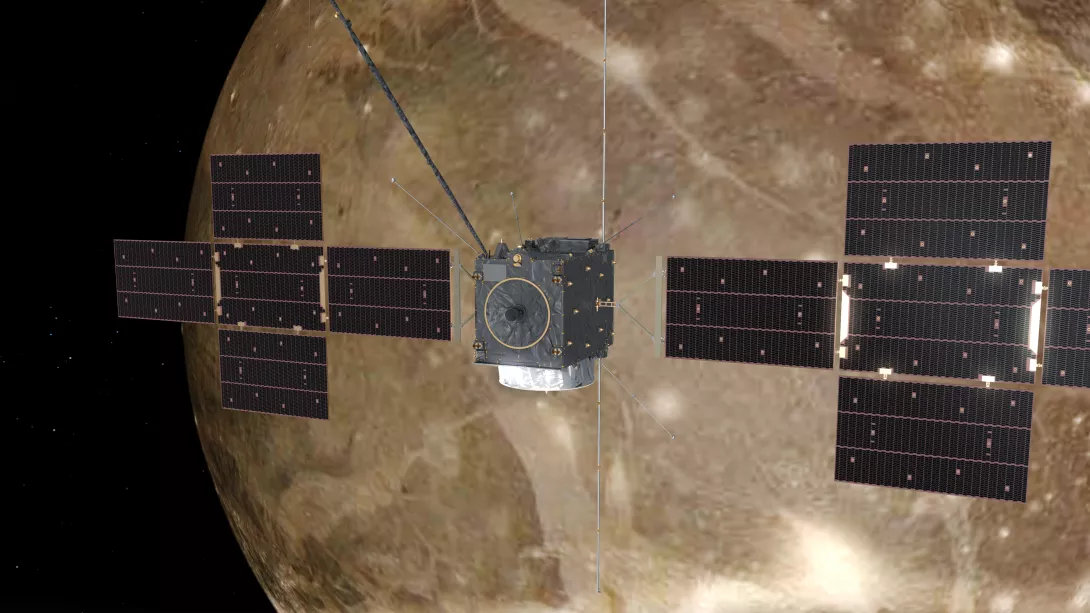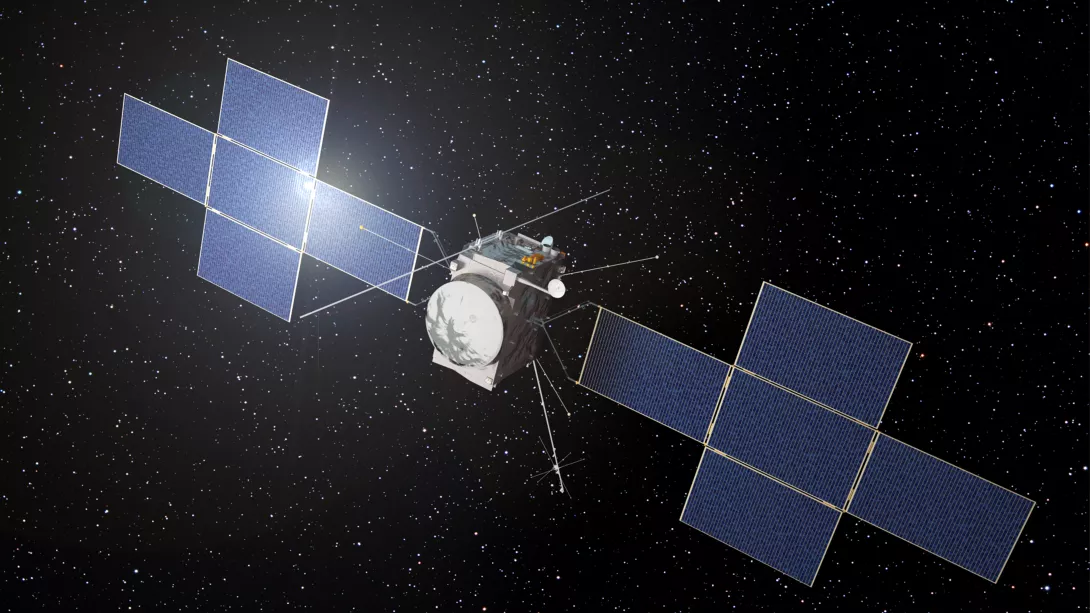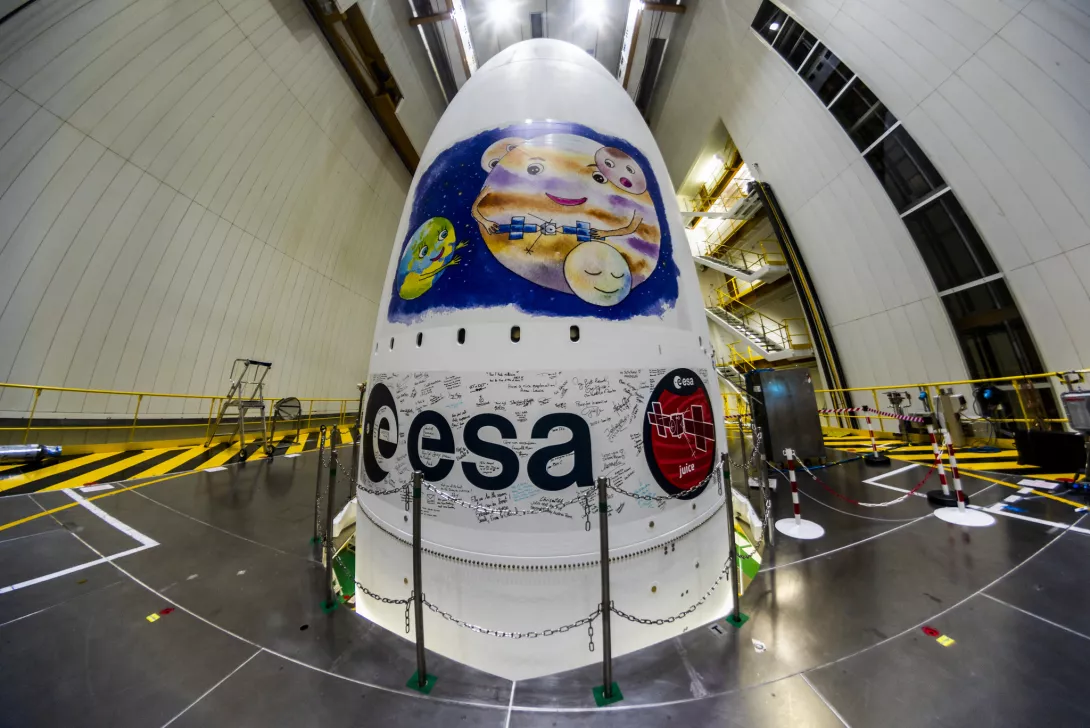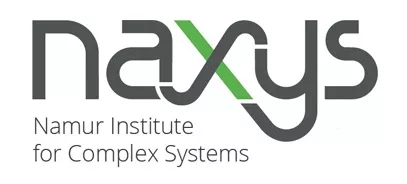After a launch attempt on April 13 at 2:15 pm delayed due to a storm, the Jupiter Icy Moons Explorer spacecraft, designated by the acronym JUICE, finally left Earth from Kourou in French Guiana thanks to an Ariane 5 rocket on April 14 at 2:14 pm for an 8-year journey to reach the 5th and largest planet in our solar system. JUICE is scheduled to approach Jupiter in July 2031 and then study three of the four Galilean satellites — Callisto, Europa, and Ganymede — thanks to some flybys of these moons before orbiting around Ganymede in December 2034 for a more in-depth study that is set to conclude in September 2035. At the end of its mission in about ten years, the probe is programmed to crash onto the surface of Ganymede.

The JUICE spacecraft has a mass of about 5.1 tonnes and uses solar panels to generate its electricity. It carries about 285 kilograms of scientific instrumentation. These include spectrometers to study the composition of the moons' soil and atmosphere, a camera and an altimeter to make a topographic map of their surface, a radar to study the surface layers of the subsurface, including the ice crust and any oceans, a radio experiment to deduce the internal structure of the stars, a magnetometer, and field and particle measurement instruments to determine the characteristics of the space environment.
While waiting for JUICE to arrive at Jupiter, Alexis Coyette will simulate the rotation of a series of interior models of Ganymede that are compatible with its mass, radius, and moment of inertia. Comparing the modeled data with the in situ data observed by JUICE in 2034 will allow for the determination of the models that best match with reality and thus constrain the interior of Ganymede. The verdict will come in 10 years!
Studying the rotation to constrain the internal composition
By spinning a raw or a hard-boiled egg, we have all witnessed how the internal structure of a rotating object influences its rotation. Similarly, the rotation of a celestial body is not the same if it is entirely solid or has a liquid layer. Based on this principle, JUICE will allow us to learn more about the internal structure of Jupiter's satellites. During its orbital phase around Ganymede, JUICE will collect data on variations in the rotation of this satellite. The analysis of this rotation data will allow us to deduce the internal structure of Ganymede.
Ganymede: a particularly interesting moon to study
Being far from the Sun, Ganymede is an icy moon on its surface. However, under pressure, this ice is expected to transform into liquid water below a certain depth. Ganymede would thus contain a global subsurface ocean containing more liquid water than on the surface of the Earth! Now, where there is liquid water, there is also potential for life. Therefore, it is possible that there is life inside this ocean, just as there is in the depths of the abysses of our oceans.
Ganymede is the largest satellite in our solar system and is also the only satellite that has its own magnetic field. A magnetic field is generated by the movement of charged particles from a liquid core of a celestial body that is large enough. If there is life inside Ganymede's global ocean, the presence of this magnetic field would have protected it from the radiation of the Sun and Jupiter, as is also the case on Earth.
JUICE: a 100% European mission
Selected in 2012 among 4 candidate missions, the JUICE mission is the first L-class (L for Large) mission of the European Space Agency's Cosmic Vision program and will be the flagship mission of the Agency for the coming decade. It is the first time that ESA sends an analytical probe so far into the Solar System!

In the framework of this project, ESA has organised two competitions for the public.

Juice up your rocket!
The first was a drawing competition inviting children up to the age of 12 to create an illustration to decorate the huge Ariane V rocket that propelled the JUICE mission on its long journey to Jupiter. The winner, accompanied by a legal guardian, has been invited by ESA to watch the JUICE launch live from one of ESA's centres. The winner, 8-year-old Yaryna, is a little girl from Ukraine.
The winning drawing and the other 11 finalists illustrate the pages of the JUICE 2023 calendar that can be found on the ESA website here (PDF).
Space Juice
Based on the fact that the acronym JUICE means juice in English, ESA also organised a "Space Juice" competition open to citizens of the agency's Member States, as well as associate and cooperating countries. The principle was rather simple: post on a social network (Facebook, Instagram, Pinterest, TikTok, Twitter and YouTube) your original recipe for a non-alcoholic 'cocktail' (Space Juice) inspired by the mission.
Planet Interior: a BELSPO project
The SPACE pole of the Namur Institute of Research naXys is involved in the JUICE mission thanks to an ESA BELSPO - Prodex funding (2023-2025). This research pole deals with the modeling of the Universe at different scales: space debris, the solar system, extrasolar systems, and up to the large-scale structures of the Universe. Within the pole, researchers focus on the nonlinear interactions and chaotic dynamics of these physical objects, using tools from celestial mechanics and cosmology.
As part of the Prodex Planet Interior contract, researchers from UNamur (Dr. Alexis Coyette, PI: Prof. Anne-Sophie Libert), in partnership with the Royal Observatory of Belgium (PI: Prof. Tim Van Hoolst), are studying interior and rotation models of Jupiter's moons, Europa and Ganymede, whose rotation will be analyzed by JUICE.
A long tradition in the field of complex planetary systems
This is not the first BELSPO Prodex contract in which UNamur is involved. In 2018, Professor Anne Lemaître was involved in the BepiColombo project, the first European mission to Mercury. Launched on October 20, 2018, this probe is currently on a seven-year journey to the smallest and least explored terrestrial planet in our solar system. When it will arrive around Mercury in late 2025, it will withstand temperatures above 350°C and collect data during its nominal one-year mission, with a possible one-year extension. The mission consists of two spacecraft: the Mercury Planetary Orbiter (MPO) and the Mercury Magnetospheric Orbiter (Mio). BepiColombo is a joint mission of ESA and the Japan Aerospace Exploration Agency (JAXA), executed under the leadership of ESA. Under the BELSPO contract, Anne Lemaître's team focused on Mercury's rotation in order to evaluate the planet's core structure and composition.
More information on the BepiColombo project on the UNamur website
UniversEH: new opportunities in the field of space
Since December 2022, UNamur has been part of the European alliance European Space University for Earth and Humanity (UniversEH), which focuses on the theme of space. This is a real recognition of UNamur's expertise in the field of space, and a gateway to new international collaborations in both teaching and research, in a field that offers employment and socio-economic development.

Upcoming activities of the naXys Institute SPACE pole
From July 3rd to 7th, 2023, the naXys Institute is organizing the international conference Complex Planetary Systems II (CPSII), a Symposium of the International Astronomical Union that has received the Kavli label for its interdisciplinarity, and which will welcome 150 international researchers, specialists in planetary systems.
All planetary systems, from the Earth-Moon system to extrasolar systems, are complex systems that require several levels of expertise and interdisciplinarity to be fully understood. Building on the success of the first edition "Complex Planetary Systems" in 2014, CPSII aims to present the latest findings obtained from this perspective and to generate new collaborations between different disciplines for the future.

